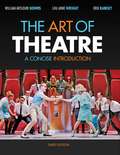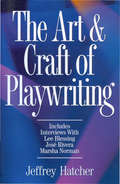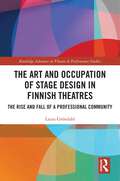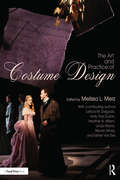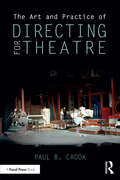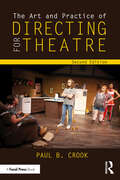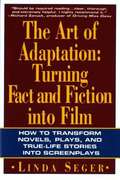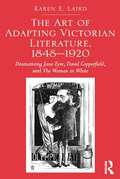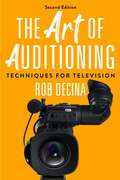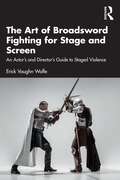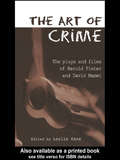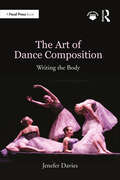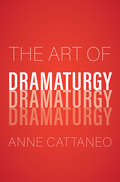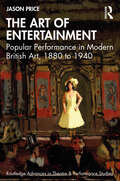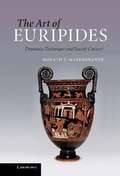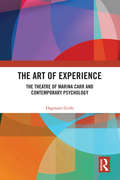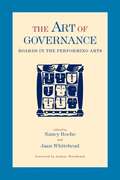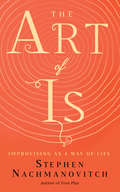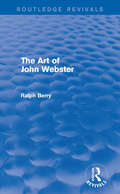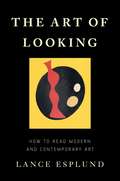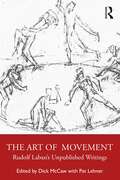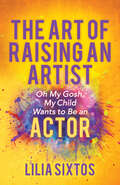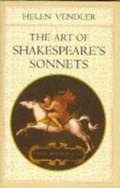- Table View
- List View
The Art Of Theatre: A Concise Introduction
by William Downs Erik Ramsey Lou WrightTHE ART OF THEATRE: A CONCISE INTRODUCTION, Third Edition, explores issues of cultural diversity and creativity, presents a full day-in-the-life of theatre, and offers briefer coverage of theatre history. The authors make timely and relevant connections between theatre and the familiar world of television and film to help students understand how the living art of theatre relates to and influences today's screen entertainment.
The Art and Craft of Playwriting
by Jeffery HatcherJeffrey Hatcher knows the nuts and bolts of writing for the theater. Here, he shares his views on it all--from building tension and plotting a scene, right down to moving a character from one side of the stage to the other. From crafting an intriguing beginning to delivering a satisfying ending.In Hatcher's one-on-one discussions with acclaimed American playwrights Lee Blessing, Marsha Norman and Jose Rivera, you'll find a wealth of practical advice, tricks of the trade and insight that will help you in your own creative efforts.
The Art and Occupation of Stage Design in Finnish Theatres: The Rise and Fall of a Professional Community (ISSN)
by Laura GröndahlThis study explores the formation, establishment, expansion, and disintegration of stage design as a modern profession and a recognized artform in Finnish theatres.Drawing on oral or written recollections and thoughts of stage designers from different decades, the author asks how their artistic agencies, occupational identities, and theoretical self-understanding have been constituted. She analyses Finnish theatre history from new perspectives by shifting the focus from finished performances to largely unknown practices behind the scenes. This book examines the cultural institutions that have constituted the stage designers’ role and position, like the professional city theatre system, the craft union, and education. This research shows how modern and postmodern scenographic innovations have been assimilated to local contexts, and how material and cultural circumstances have reshaped the artistic practices. Without bypassing canonical trendsetters or hegemonic cultural mindsets, the focus is directed on the everyday grassroot level of stage design practices. Personal interviews with over 20 designers make visible an ample repertoire of unwritten knowledge stored in habitual ways of working and dealing creatively with the complex system of theatre making.This book will be of great interest to students and scholars in theatre and performance studies with a focus on scenography.
The Art and Practice of Costume Design
by Melissa L. MerzIn The Art and Practice of Costume Design, a panel of seven designers offer a new multi-sided look at the current state and practice of theatrical costume design. Beginning with an exploration of the role of a Costume Designer, the subsequent chapters analyse and explore the psychology of dress, the principles and elements of design, how to create costume renderings, and collaboration within the production. The book also takes a look at the costume shop and the role of the designer within it, and costume design careers within theatrical and fashion industries.
The Art and Practice of Directing for Theatre
by Paul B. CrookThe formation and communication of vision is one of the primary responsibilities of a director, before ever getting to the nuts and bolts of the process. The Art and Practice of Directing for Theatre helps the young director learn how to discover, harness, and meld the two. Providing both a practical and theoretical foundation for directors, this book explores how to craft an artistic vision for a production, and sparks inspiration in directors to put their learning into practice. This book includes: Guidance through day-to-day aspects of directing, including a director’s skillset and tools, script analysis, and rehearsal structure. Advice on collaborating with production teams and actors, building communication skills and tools, and integrating digital media into these practices. Discussion questions and practical worksheets covering script analysis, blocking, and planning rehearsals, with downloadable versions on a companion website.
The Art and Practice of Directing for Theatre
by Paul B. CrookThe formation and communication of vision is one of the primary responsibilities of a director, before ever getting to the nuts and bolts of the process. The Art and Practice of Directing for Theatre, Second Edition helps the young director learn how to discover, harness, and meld the two.Providing both a practical and theoretical foundation for directors, this book explores how to craft an artistic vision for a production, and sparks inspiration in directors to put their learning into practice. This new edition is fully revised to address changes in theatre since the Covid pandemic, new technology, intimacy direction, and inclusive practices. It features: Guidance through day-to-day aspects of directing, including a director’s skillset and tools, script analysis, and rehearsal structure. Advice on collaborating with production teams and actors, building communication skills and tools, and integrating digital media into these practices. Discussion questions and practical worksheets covering script analysis, blocking, and planning rehearsals. Updated references to reflect the changes in the theatre community and profession since the original writing. Updated examples of studies and technology. This book is written for students in Theatre Directing courses, along with new and aspiring theatrical directors. The Art and Practice of Directing for Theatre, Second Edition includes access to downloadable worksheets, available at www.routledge.com/9781032619514.
The Art of Adaptation: Turning Fact and Fiction Into Film (Owl Books Ser.)
by Linda SegerAdaptations have long been a mainstay of Hollywood and the television networks. Indeed, most Academy Award- and Emmy Award-winning films have been adaptations of novels, plays, or true-life stories. Linda Seger, author of two acclaimed books on scriptwriting, now offers a comprehensive handbook for screenwriters, producers, and directors who want to successfully transform fictional or factual material into film. Seger tells how to analyze source material to understand why some of it resists adaptation. She then gives practical methods for translating story, characters, themes, and style into film. A final section details essential information on how to adapt material and how to protect oneself legally
The Art of Adapting Victorian Literature, 1848-1920: Dramatizing Jane Eyre, David Copperfield, and The Woman in White
by Karen E. LairdIn The Art of Adapting Victorian Literature, 1848-1920, Karen E. Laird alternates between readings of nineteenth-century stage and twentieth-century silent film adaptations to investigate the working practices of the first adapters of Victorian fiction. Laird’s juxtaposition between stage and screen brings to life the dynamic culture of literary adaptation as it developed throughout the long nineteenth-century. Focusing on Charlotte Brontë’s Jane Eyre, Charles Dickens’s David Copperfield, and Wilkie Collins’s The Woman in White, Laird demonstrates how adaptations performed the valuable cultural work of expanding the original novel’s readership across class and gender divides, exporting the English novel to America, and commemorating the novelists through adaptations that functioned as virtual literary tourism. Bridging the divide between literary criticism, film studies, and theatre history, Laird’s book reveals how the Victorian adapters set the stage for our contemporary film adaptation industry.
The Art of Auditioning: Second Edition
by Rob DecinaLearn how to ace your acting audition from a top casting director!Casting Director Rob Decina highlights the difference between the craft of acting and the business of auditioning, and how those two worlds meet in television. Included are proven-effective preparation techniques, including asking the right questions, making specific acting choices, finding beats and beat changes, using spontaneity, and much more. Also included is advice on headshots and resumes and an examination of the difference between audition preparation and theatrical preparation as well as information on how to succeed with self-tape auditions.This updated edition will include both new and updated tips, as well as reflections on the original edition's advice. Rob's career has spanned primetime television, daytime drama, film, to casting for the one of the most prolific television studios for dramas and comedies across network, cable and streaming platforms.
The Art of Broadsword Fighting for Stage and Screen: An Actor’s and Director’s Guide to Staged Violence
by Erick Vaughn WolfeThe Art of Broadsword Fighting for Stage and Screen provides historical and contemporary techniques and styles for the safe training and use of the European broadsword in a theatrical setting.This book starts with a brief breakdown of the history of broadswords, the time periods associated with their use, and the influences of historical masters and their manuscripts. After the brief history section, this book presents the basic techniques of broadsword fighting, starting with grip and body postures. Readers will then move fluidly into the basic actions of cuts, parries, blocks, and disarms. During this process, actors explore the connection between body and weapon and start learning the elements of storytelling through choreography. Special attention is given throughout the text on techniques which need to be approached in a physically and/or mentally safe way by directors, choreographers, performers, teachers, and students. The final chapter focuses on choreographing a fight and utilizing all the material previously covered in this book, with special notes for actors, directors, and teachers about what makes a good fight, how to keep it safe, and how to create the "wow factor" in choreography.The Art of Broadsword Fighting for Stage and Screen is intended for directors, choreographers, actors, students of acting, martial artists, and enthusiasts of stage combat and historical martial arts.
The Art of Crime: The Plays and Film of Harold Pinter and David Mamet (Studies in Modern Drama #21)
by Leslie KaneFirst Published in 2004. Routledge is an imprint of Taylor & Francis, an informa company.
The Art of Dance Composition: Writing the Body
by Jenefer DaviesThe Art of Dance Composition: Writing the Body is an introduction to modern dance composition, providing clear and structured approaches to designing and defining movement that demystify the creative process.The book introduces the concepts of creating authentic movement, processes for gathering and ordering compositional elements, and the ways in which theme, story, and design relate to bodies moving through space. It approaches the practice of composition from many avenues, including the use of digital tools such as video and video editing software, digital mapping, and motion capture, and through improvisation, sourced gestures, and inspiration from visual art, found objects, and chance methodology. Flowcharts that organize and provide a framework for making dance are included, equipping readers with a clear roadmap for creating their own work.Filled with practical advice, this book is suitable for all aspiring choreographers.The Art of Dance Composition: Writing the Body includes access to performance videos that demonstrate the concepts illustrated in the book. To access the videos, visit www.daviesanddancers.com/links-to-writing-the-body.
The Art of Dramaturgy
by Anne CattaneoAn introduction to the mysterious theater role of a dramaturg by a legend in the field Anne Cattaneo was among the first Americans to fill the role of dramaturg, one of theater&’s best kept secrets. A combination of theater artist, scholar, researcher, play advocate, editor, and writer&’s friend, it is the job of a dramaturg to &“reflect light back on the elements that are already in play,&” while bringing a work of theater to life. Cattaneo traces the field from its beginnings in the eighteenth century to the present and chronicles the multitude and variety of tasks a dramaturg undertakes before, during, and after a production is brought to the stage. Using detailed stories from her work with theater artists such as Tom Stoppard, Wendy Wasserstein, Robert Wilson, Shi-Zheng Chen, and Sarah Ruhl, as well as the discovery of a &‘lost&’ play by Langston Hughes and Zora Neale Hurston, Cattaneo provides an invaluable manual to those studying, working in, and interested in this most fascinating profession.
The Art of Entertainment: Popular Performance in Modern British Art, 1880 to 1940 (ISSN)
by Jason PriceIn this book, theatre historian Jason Price looks at the relationships and exchanges that took place between high and low cultural forms in Britain from 1880 to 1940, focusing on the ways in which figures from popular entertainments, such as music hall serio-comics, clowns, and circus acrobats, came to feature in modern works of art.Readers with an interest in art, theatre, and the history of modern Britain will find Price’s approach, which sees major works of art used to illuminate the histories of once-famous entertainers and the wider social, political, and cultural landscape of this period, accessible and engaging. The book will bring to life for readers some of the most vivid works of modern British art and reveal how individuals historically overlooked due to their gender, sexuality, or race played a significant role in the shaping of British culture during this period of monumental social change.
The Art of Euripides: Dramatic Technique and Social Context
by Donald J. MastronardeIn this book Professor Mastronarde draws on the seventeen surviving tragedies of Euripides, as well as the fragmentary remains of his lost plays, to explore key topics in the interpretation of the plays. It investigates their relation to the Greek poetic tradition and to the social and political structures of their original setting, aiming both to be attentive to the great variety of the corpus and to identify commonalities across it. In examining such topics as genre, structural strategies, the chorus, the gods, rhetoric, and the portrayal of women and men, this study highlights the ways in which audience responses are manipulated through the use of plot structures and the multiplicity of viewpoints expressed. It argues that the dramas of Euripides, through their dramatic technique, pose a strong challenge to simple formulations of norms, to the reading of consistent human character, and to the quest for certainty and closure.
The Art of Experience: The Theatre of Marina Carr and Contemporary Psychology
by Dagmara GizłoThe Art of Experience provides an interdisciplinary analysis of selected plays from Ireland’s premier female playwright, Marina Carr. Dagmara Gizło explores the transformative impact of a theatrical experience in which interdisciplinary boundaries must be crossed. This book demonstrates that theatre is therapeutic and therapy is theatrical. The role of emotions, cognitions, and empathy in the theatrical experience is investigated throughout. Dagmara Gizło utilises the methodological tools stemming from modern empirically grounded psychology (such as cognitive-behavioural therapy or CBT) to the study of theatre’s transformative potential. This book will be of great interest to students and scholars of theatre, performance, and literature, and will be a fascinating read for those at the intersection of cognitive studies and the humanities.
The Art of Governance
by Nancy Roche Jaan WhiteheadThe Art of Governance is an essential guide for trustees in the performing arts and for the artists, managers, and community leaders who work with them. This book provides the larger context in which trustees govern--the art, artists, history, institutions, and national policies of the performing arts--and also explores more practical issues, such as board development, planning, finance, and fundraising. A wide range of distinguished artists, trustees, managers, and consultants have contributed articles, covering everything from "The Art of Theater" to "Understanding Financial Statements." An invaluable tool for building an enlightened and inspired board, this resource above all recognizes the need of trustees in the performing arts to find a balance between the uncertainty of artistic creativity and the need for fiscal stability.Editors Nancy Roche and Jaan Whitehead have served on the boards and staff of numerous theater organizations.Nancy Roche has been a trustee of CENTER-STAGE in Baltimore since 1987, serving as president of the board for seven years and as interim managing director for one year. She has been a consultant on governance for the National Arts Stabilization (now National Arts Strategies), a councilor of the Maryland State Arts Commission from 1992-1999, and has twice served as lay panelist for the NEA. In the summer of 2000, she participated as a theater trustee in the National Critics' Institute at the Eugene O'Neill Theater Center in Waterford, Connecticut, returning in the following summer as a founding member of their week-long Trustees Program. She is a founding member of the National Council for the American Theatre and serves as a trustee and treasurer of the board of Theatre Communications Group. In addition, she serves on the boards of the Roland Park Country School, the Institute for Christian-Jewish Studies, and the Baltimore School for the Arts. She is a graduate of Dominican University and received an MA in teaching and an LLA, both from The Johns Hopkins University.Jaan Whitehead currently chairs the board of the SITI Company, an ensemble theater in New York led by Anne Bogart. She has served on the boards of The Acting Company, Arena Stage, Living Stage, and The Whole Theatre Company, where her particular interests have been board development and institutional change. She has also been a trustee of Theatre Communications Group and the National Cultural Alliance, an arts advocacy group in Washington, and is a founding member of the National Council for the American Theatre. In addition to her work as a trustee, she has been executive director of Theatre for a New Audience in New York and Development Director of CENTERSTAGE in Baltimore.Ms. Whitehead graduated from Wellesley College, holds and MA in economics from the University of Michigan, and, early in her career, works as an economist for private industry and the Federal Reserve Board. She received her PhD in political theory fro Princeton in 1988. She taught at Georgetown University for several years but, as her involvement in theater deepened, she made the arts her main work while retaining her interests in economic and political theory. Drawing on this background, she has recently been writing a series of essays on the challenges facing the arts in a commercial society.
The Art of Is: Improvising as a Way of Life
by Stephen NachmanovitchA MASTERFUL BOOK ABOUT BREATHING LIFE INTO ART AND ART INTO LIFE &“Stephen Nachmanovitch&’s The Art of Is is a philosophical meditation on living, living fully, living in the present. To the author, an improvisation is a co-creation that arises out of listening and mutual attentiveness, out of a universal bond of sharing that connects all humanity. It is a product of the nervous system, bigger than the brain and bigger than the body; it is a once-in-a-lifetime encounter, unprecedented and unrepeatable. Drawing from the wisdom of the ages, The Art of Is not only gives the reader an inside view of the states of mind that give rise to improvisation, it is also a celebration of the power of the human spirit, which — when exercised with love, immense patience, and discipline — is an antidote to hate.&” — Yo-Yo Ma, cellist
The Art of John Webster (Routledge Revivals)
by Ralph BerryThe Art of John Webster, first published in 1972, is a study of the three extant plays of Webster known to be solely his work. These plays are seen as attempts to achieve in literature the effects of the baroque, a term which related Webster to the larger developments of European art. Their content is analysed in terms of a consistent opposition between evil and the law. The book seeks to re-establish a base for the claims that must be made for Webster as a serious artist. This title will be of interest to students of literature and drama.
The Art of Knife Fighting for Stage and Screen: An Actor’s and Director’s Guide to Staged Violence
by Erick Vaughn WolfeThe Art of Knife Fighting for Stage and Screen: An Actor’s and Director’s Guide to Staged Violence provides detailed information for the safe use of knives and daggers in a theatrical setting and an in-depth understanding of safe theatrical weapons. The book starts with an extensive safety review, then moves on to the basic techniques of dagger fighting, starting with grip and body postures. Readers will then learn about the basic actions of cuts, parries, blocks, and disarms. During this process, they will explore the connection between body and weapon and start learning the elements of storytelling through choreography. Special attention is given to suicides, threats, and murder and how directors, choreographers, performers, teachers, and students can approach these techniques in a way that is physically and mentally safe. The book also covers the use of throwing knives, knife flips, and other tricks to help add a little flair to your fight. The Art of Knife Fighting for Stage and Screen teaches the safe theatrical use of the knife for directors, performers, educators, and students of stage combat.
The Art of Looking: How to Read Modern and Contemporary Art
by Lance EsplundA veteran art critic helps us make sense of modern and contemporary artThe landscape of contemporary art has changed dramatically during the last hundred years: from Malevich's 1915 painting of a single black square and Duchamp's 1917 signed porcelain urinal to Jackson Pollock's midcentury "drip" paintings; Chris Burden's "Shoot" (1971), in which the artist was voluntarily shot in the arm with a rifle; Urs Fischer's "You" (2007), a giant hole dug in the floor of a New York gallery; and the conceptual and performance art of today's Ai Weiwei and Marina Abramovic. The shifts have left the art-viewing public (understandably) perplexed.In The Art of Looking, renowned art critic Lance Esplund demonstrates that works of modern and contemporary art are not as indecipherable as they might seem. With patience, insight, and wit, Esplund guides us through the last century of art and empowers us to approach and appreciate it with new eyes. Eager to democratize genres that can feel inaccessible, Esplund encourages viewers to trust their own taste, guts, and common sense. The Art of Looking will open the eyes of viewers who think that recent art is obtuse, nonsensical, and irrelevant, as well as the eyes of those who believe that the art of the past has nothing to say to our present.
The Art of Movement: Rudolf Laban’s Unpublished Writings
by Dick McCawThe Art of Movement: Rudolf Laban’s Unpublished Writings offers new perspectives on the thinking and practice of Rudolf Laban – one of the pioneers of modern European dance and movement analysis. A wealth of Laban’s previously untranslated writings broadens our understanding of his work through new perspectives on his thinking and practice. Alongside these key primary sources, interviews with Laban’s family and colleagues and editorial commentaries shed new light on the significance of his life and career. Laban’s own texts also offer further elaboration of the key themes of his work – eukinetics, choreutics, lay dance, pedagogy and dance notation. This essential companion to The Laban Sourcebook is an ideal resource for any students or scholars of modern dance, dance studies, dance history and movement analysis looking for a deeper understanding of this seminal figure in their field.
The Art of Raising an Artist: Oh My Gosh, My Child Wants to Be an Actor
by Lilia SixtosThe Art of Raising an Artist guides parents in helping their children explore the world of acting and ultimately invest in their child’s future.Actor and director, Lilia Sixtos has seen thousands of auditions and taught hundreds of artists. By raising her two creative children, she has learned every possible way a creative person’s journey can be helped or hindered by their parents. In The Art of Raising an Artist, she shows parents how to:Identify the best training they can provide for their child within their meansDevelop a safe and loving space for the challenges of their child’s journeyCreate the support team their child needsFind their child’s nicheFit the needs of their child’s career with the needs of the whole family
The Art of Shakespeare's Sonnets
by Helen VendlerThis book critically analyses Shakespeare's sonnets quoting some of his poetic beauties.
The Art of Shakespeare's Sonnets
by Helen VendlerHelen Vendler, widely regarded as our most accomplished interpreter of poetry, here serves as an incomparable guide to some of the best-loved poems in the English language. In detailed commentaries on Shakespeare's 154 sonnets, Vendler reveals previously unperceived imaginative and stylistic features of the poems, pointing out not only new levels of import in particular lines, but also the ways in which the four parts of each sonnet work together to enact emotion and create dynamic effect. The commentaries--presented alongside the original and modernized texts--offer fresh perspectives on the individual poems, and, taken together, provide a full picture of Shakespeare's techniques as a working poet. With the help of Vendler's acute eye, we gain an appreciation of "Shakespeare's elated variety of invention, his ironic capacity, his astonishing refinement of technique, and, above all, the reach of his skeptical imaginative intent. " Vendler's understanding of the sonnets informs her readings on an accompanying compact disk, which is bound with the book. This recorded presentation of a selection of the poems, in giving aural form to Shakespeare's words, heightens our awareness of voice in lyric, and adds the dimension of sound to poems too often registered merely as written words.
